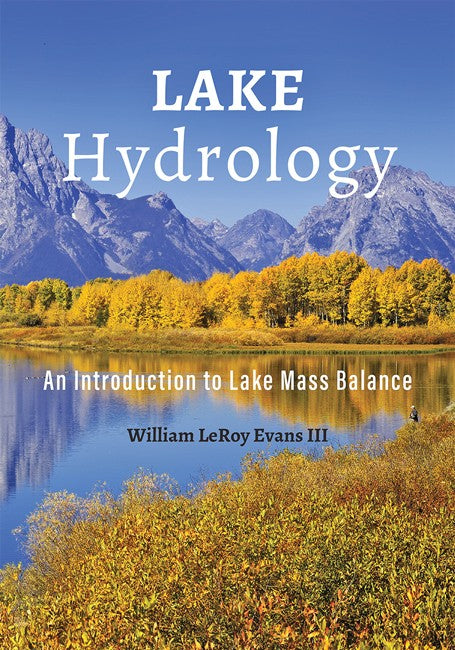William LeRoy Evans III is an environmental scientist, hydrogeologist, and certified professional geologist. He is the president of E III Environmental Consulting Company Inc.
Request Academic Copy
Please copy the ISBN for submitting review copy form
Description
Preface Acknowledgments Chapter 1. Introduction 1.1. Limnology 1.2. Dimensions, Units, Measurements, and Mathematical Conventions 1.3. Dimensional Analysis 1.4. Spatial Coordinates 1.5. Mathematics and Statistics Chapter 2. Water and the Hydrologic Cycle 2.1. Water and Its Properties 2.2. The Hydrologic Cycle 2.3. Mass Balance of Water Chapter 3. Drainage Basins, Lentic Systems, Lake Morphometry, and Lake Volume 3.1. Drainage Basins 3.2. Lentic Systems 3.3. Solar Radiation 3.4. Lake Morphometry 3.5. Lake Volume or Storage Case Study 3.1. City of Winters, Texas, Elm Creek Dam and Reservoir 3.6. Summary Chapter 4. Evapotranspiration 4.1. Introduction 4.2. Evaporation 4.3. Transpiration 4.3.1. Xylem Transport 4.4. Molecular Movement of Water 4.5. Estimates of Evapotranspiration 4.6. Summary Chapter 5. Rainfall and Surface Flow to Lakes 5.1. Introduction 5.2. Precipitation 5.3. Measuring Precipitation Case Study 5.1. Hastings, Nebraska, Isohyetal Map Case Study 5.2. Hastings, Nebraska, Thiessen Polygon Case Study 5.3. Stanley River Catchment, Queensland, Australia 5.4. Presentation of Rainfall Data Chapter 6. Stormwater Flow 6.1. Introduction 6.2. Variable Source Areas 6.3. Storm Runoff and Baseflow 6.4. Separation of Baseflow and Quickflow Case Study 6.1. Little Bighorn River Groundwater Recharge Case Study 6.2. Indirect Groundwater Discharge to the Great Lakes Using Hydrograph Separation 6.5. Losses 6.6. Urban Runoff and Consumptive Use Case Study 6.3. Impacts of Water Development on Great Salt Lake and the Wasatch Front 6.6.3. Implications 6.7. Summary Chapter 7: Methods for Estimating Storm Runoff 7.1. Introduction 7.2. Characterizing Rainfall Events 7.3. Runoff Models for Small- to Medium-Sized Catchments Case Study 7.1. Stormwater Runoff Assessment Using Rational Method Case Study 7.2. Stormwater Runoff Assessment Using Soil Conservation Service Method 7.4. Hydrographs 7.6. Summary Chapter 8. Streamflow to Lakes 8.1. Introduction 8.2. Velocity Distribution and Uniform Flow within Stream Channels 8.3. Calculating Channel Flow 8.4. Streamflow Hydrographs and Field Measurements for Determining Streamflow Chapter 9. Groundwater Flow 9.1. Introduction 9.2. Groundwater Systems 9.3. Groundwater Hydraulics 9.4. Fluids in Motion: Laminar and Turbulent Flow 9.5. Molecular Attraction, Fluid Viscosity, Friction, Head Loss, and Laminar Flow 9.6. Darcy's Law 9.7. Hydraulic Head and Hubbert's Classic Treatise on Fluid Potential 9.8. Head Loss 9.9. Hydraulic Properties of a Porous Medium 9.10. Continuum Concept and Representative Elementary Volume 9.11. Hydraulic Gradients, Boundary-Value Problem, and Direction of Flow 9.12. Field Mapping Equipotential Lines and Flow Nets 9.13. Summary Chapter 10. Lake Seepage 10.1. Introduction 10.2. General Lake-Groundwater Interactions 10.3. Determining Seepage 10.4. Seepage and Average Linear Velocity 10.5. Construction and Placement of Seepage Meters Case Study 10.1. Methods for Measuring Hydraulic Conductivity at Lake Jackson, Leon County, Florida 10.6. Lake Bottom and Hydraulic Conductivity Heterogeneities Case Study 10.2. Hypsometric Effects and Lake Bottom Hydraulic Conductivity Modeling of Lake Jackson, Leon County, Florida 10.7. Ecological Indicators of Lake Seepage 10.8. Summary Chapter 11. An Overview of Lake Hydrology Modeling, Lake Mass Balance, and Hypsometry 11.1. Systems 11.2. Model Process 11.3. Model Types Case Study 11.1. Lake Mass Balance and Hypsometry Case Study 11.2. Numerical Simulation Analyses of Lake-Groundwater Interaction Case Study 11.3: Polynomial Regression Seepage Model of Lake Jackson, Leon County, Florida Case Study 11.4. Seepage Modeling of Lake Jackson, Leon County, Florida 11.4. Development of a Model 11.5. Model Selection, Validation, Calibration, and Documentation 11.6. Summary Appendix References Index

